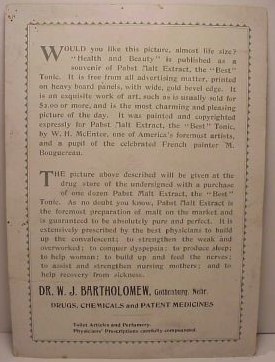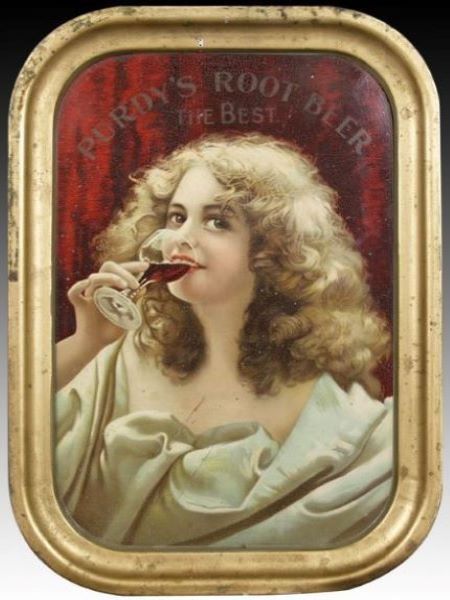The 'Stock' Exchange
Tuscarora Advertising Co. "Health & Beauty"
Tuscarora Advertising Co. "Health & Beauty"
Date: 1890 - 1901
Size: 13.5" x 16.5"
Type: Plate
Scarcity: Extremely Rare
Value: $$$ - $$$$
Condition & Brewer Dependent
Size: 13.5" x 16.5"
Type: Plate
Scarcity: Extremely Rare
Value: $$$ - $$$$
Condition & Brewer Dependent
Click the Picture to Return to Meek & Beach Stock Catalog Page


Aside from Pabst, there are a couple of wine manufacturers and retailers, and odd collection of miscellaneous businesses and two brewing companies (Theo. Knapstein Brewing of New London, WI & Schumann Menges Brewing Co. Prarie du Chien, British Columbia, Canada).
Sahling’s workbook start in January 1899, but early entries just list the name of client but do not indicate the medium (Sahling worked on calendars, print ads, plaques, cuts outs, plates, match safes, tip trays, badges, banners, and medallions in addition to trays). The first mention of a tray specifically does not occur until January 1900 with an entry for Los Angeles Brewing Co (tray). There is an entry in October 1899 that simply says “Pabst” which possibly could be for the Pabst Malt Tonic version of this design.
Size, Shape and Message Placement
All tray examples we’ve seen are large oblongs (12 ½ by 16 ½) with a rim style that is unique to Tuscarora/Meek & Beach/Meek; it has a two-step rim with a short initial wall that transitions into a concave section and then finally into a wide, flat edge which we understand is the product of the specific stamping machines used. Unlike later stock designs, there does not seem to have been a standard rim color; we’ve found examples in gold, silver (on the Pabst Malt Extract example) and a patterned yellow and gold one with grape vines. Some examples have advertising text in black or gold on the face. The Wilson’s Invalid Port Wine example has large, highlighted yellow text on the face, while the Pabst example has red text and small images of bottles on the rim. It’s safe to say that Tuscarora had not yet completed settled it stock design approach.
Hager & Price
Hager does not discuss or include this design in his article, and it is not in his catalog. Not counting the Pabst Malt Tonic version (probably the most frequently encountered) the only brewery examples we’ve seen mentioned above which were in average condition and realized prices in the low triple figures. Some of the Pabst versions did a little better, but in general most examples we’ve seen have been in average condition or a little worse. Not surprisingly, prices tend to stay in the mid-to-upper double figures or low triple figures.
Sahling’s workbook start in January 1899, but early entries just list the name of client but do not indicate the medium (Sahling worked on calendars, print ads, plaques, cuts outs, plates, match safes, tip trays, badges, banners, and medallions in addition to trays). The first mention of a tray specifically does not occur until January 1900 with an entry for Los Angeles Brewing Co (tray). There is an entry in October 1899 that simply says “Pabst” which possibly could be for the Pabst Malt Tonic version of this design.
Size, Shape and Message Placement
All tray examples we’ve seen are large oblongs (12 ½ by 16 ½) with a rim style that is unique to Tuscarora/Meek & Beach/Meek; it has a two-step rim with a short initial wall that transitions into a concave section and then finally into a wide, flat edge which we understand is the product of the specific stamping machines used. Unlike later stock designs, there does not seem to have been a standard rim color; we’ve found examples in gold, silver (on the Pabst Malt Extract example) and a patterned yellow and gold one with grape vines. Some examples have advertising text in black or gold on the face. The Wilson’s Invalid Port Wine example has large, highlighted yellow text on the face, while the Pabst example has red text and small images of bottles on the rim. It’s safe to say that Tuscarora had not yet completed settled it stock design approach.
Hager & Price
Hager does not discuss or include this design in his article, and it is not in his catalog. Not counting the Pabst Malt Tonic version (probably the most frequently encountered) the only brewery examples we’ve seen mentioned above which were in average condition and realized prices in the low triple figures. Some of the Pabst versions did a little better, but in general most examples we’ve seen have been in average condition or a little worse. Not surprisingly, prices tend to stay in the mid-to-upper double figures or low triple figures.
Confirmed Brewer used Stock Trays
Non-Beer Related & Non-Tray Uses
General Comments
This design is one of several early stock designs that may or may not carry a manufacturer signature that we’ve come to believe are pre-catalog stock designs from Tuscarora. We draw this conclusion based on some unique contours of the tray rims from the stamping process (discussed in the following section), as well as certain characteristics in rim design patterns. In the case of this design some examples do carry the Tuscarora signature. In his NABA article (Issue 101, Spring 1998), Hager raises the possibility of an earlier catalog for stock designs but can offer no definite proof in a section titled “Rims, Rims, and More Rims.” We believe this design dates from before 1900, as the earliest price list we possess (July 1900) lists the first 13 stock designs that comprise the Tuscarora/Meek&Beach/Meek/American Art Works catalog.
The title, “Health & Beauty” does not appear on any of the tray examples we have seen, but rather from some print examples (such as a trade card - see below). It also appears in a print ad placed in Harper Bazaar, in 1901, featuring this image with the text:
This design is one of several early stock designs that may or may not carry a manufacturer signature that we’ve come to believe are pre-catalog stock designs from Tuscarora. We draw this conclusion based on some unique contours of the tray rims from the stamping process (discussed in the following section), as well as certain characteristics in rim design patterns. In the case of this design some examples do carry the Tuscarora signature. In his NABA article (Issue 101, Spring 1998), Hager raises the possibility of an earlier catalog for stock designs but can offer no definite proof in a section titled “Rims, Rims, and More Rims.” We believe this design dates from before 1900, as the earliest price list we possess (July 1900) lists the first 13 stock designs that comprise the Tuscarora/Meek&Beach/Meek/American Art Works catalog.
The title, “Health & Beauty” does not appear on any of the tray examples we have seen, but rather from some print examples (such as a trade card - see below). It also appears in a print ad placed in Harper Bazaar, in 1901, featuring this image with the text:
This ad carries a copyright date of 1893 By Pabst Brewing Co., although the example comes from a September 1901 edition of Harper’s Bazaar magazine.
By the 1890’s, many American breweries were manufacturing malt extract for medicinal purposes. This thick, syrupy liquid derived from barley and grains certainly contained sugar and may have contained some nutrients. Malt Extracts were widely used as a digestive aid, and for the recovery of convalescents. But many also contained alcohol. Pabst promoted their Malt extract in a series of pamphlets asserting that their tonic is “a simple extract of Malt and Hops, precisely similar in nutrition and medicinal value to those hitherto so extensively prescribed by the entire medical profession. It is not a patent medicine.”
One trade card issued by druggist Dr. W J Bartholomew carries the following on the back:
By the 1890’s, many American breweries were manufacturing malt extract for medicinal purposes. This thick, syrupy liquid derived from barley and grains certainly contained sugar and may have contained some nutrients. Malt Extracts were widely used as a digestive aid, and for the recovery of convalescents. But many also contained alcohol. Pabst promoted their Malt extract in a series of pamphlets asserting that their tonic is “a simple extract of Malt and Hops, precisely similar in nutrition and medicinal value to those hitherto so extensively prescribed by the entire medical profession. It is not a patent medicine.”
One trade card issued by druggist Dr. W J Bartholomew carries the following on the back:
Health and Beauty are everywhere the sources of highest attainable happiness, and the greatest beauty of all is that of the healthy, hearty, robust person. A wineglass of Pabst Malt Extract the best tonic, three times a day, at meals, perhaps one at bedtime, will give you that bounding joyous health and sweet sleep that nature intended you to enjoy.
Harper's Bazaar Magazine
September 1901
Harper's Bazaar Magazine
September 1901
Would you like this picture, almost life size? “Health and Beauty” is published as a souvenir of Pabst Malt Extract the “Best Tonic”. It is free from all advertising matter, printed on heavy board panel with wide gold beveled edge. It is an exquisite work of art, such as is usually sold for $2.00 or more, and is the most charming and pleasing picture of the day. It was painted and copyrighted by W. H. McEntee, one of America’s foremost artists, and a pupil of the celebrated French painter M. Bouguereau.
The picture above described will be given at the drug store of the undersigned with a purchase of one dozen Pabst Malt Extract, the “Best” Tonic. As not doubt you know, Pabst Extract is the foremost prescribed of malt on the market and is guaranteed to be absolutely pure & perfect. It is extensively prescribed by the best physicians to build up the convalescent; to strengthen the weak and overworked; to conquer dyspepsia; to produce sleep; to help women; to build up feed the nerves; to assist and strengthen nursing mothers; and to help recover from sickness.
The picture above described will be given at the drug store of the undersigned with a purchase of one dozen Pabst Malt Extract, the “Best” Tonic. As not doubt you know, Pabst Extract is the foremost prescribed of malt on the market and is guaranteed to be absolutely pure & perfect. It is extensively prescribed by the best physicians to build up the convalescent; to strengthen the weak and overworked; to conquer dyspepsia; to produce sleep; to help women; to build up feed the nerves; to assist and strengthen nursing mothers; and to help recover from sickness.













